Just as the Bush Administration’s Faith-Based Initiative called attention to congregations’ social service activities, the 1980s rise of the Religious Right called attention to congregations’ political activities. The organized Religious Right is not what it used to be, but concerns and debates about the appropriate limits of congregations’ political involvement emerge every election season. Clarity about some basic facts might inform these debates.
In both 1998 and 2006-07, the National Congregations Study asked congregations about eight different kinds of political activities. The figure above shows the percent of churchgoers who attend congregations that have engaged in each activity within the last year (The voter guide numbers give the percent of people attending churches that have ever distributed voter guides). Some things changed between 1998 and 2006: churches became more involved in voter registration drives, Catholic churches became more politically active in general, and fewer of the voter guides distributed by churches were produced by Religious Right organizations. But I want to emphasize two things that have not changed since 1998, so this figure combines data from both surveys.
First, notwithstanding extensive media coverage of political mobilization within conservative churches, conservative white Protestant churches do not stand out in their level of political activity. Catholic and black Protestant churches, overall, are more politically active than either liberal or conservative white Protestants. About three-quarters of Catholics and black Protestants attend churches that engaged in at least one of these eight political activities, compared to about half of white Protestants, either conservative or liberal (Synagogues’ political activity rates, by the way, are as high as the Catholic and black Protestant rates).
Second, although political activity of some sort is common in American churches, religious traditions have different political styles. Distributing voter guides is the most common way that white conservative Protestant churches do politics. These churches distribute voter guides at about the same rate as Catholic and black Protestant churches do, but they are much more likely to distribute voter guides produced by Religious Right organizations. Two-thirds of the white conservative Protestant churches that distributed voter guides used guides from those sources, compared to only 1 in 5 mainline churches, 1 in 10 Catholic Churches, and 1 in 20 black churches. We tend to think of voter guides as a political tool of conservative Protestants, but mainline Protestants, black Protestants, and Catholics all have their own versions of voter guides.
Beyond voter guides, black churches are much more likely than white churches to engage in electoral politics by having a candidate or elected government official speak at the church, or by participating in voter registration drives. And Catholic churches are much more likely than Protestant churches to engage in the direct action and pressure group politics of marching, demonstrating, and lobbying elected officials.
It is difficult to say why religious groups have such different political styles. Congregations in highly centralized denominations may do politics differently than independent congregations or congregations in decentralized denominations. Religious groups also focus on different issues, and perhaps different issues elicit different political strategies and tactics. More broadly, religious groups differ in the kinds of church-based political actions they consider appropriate. All of these factors probably shape a religious group’s political style.
In any event, differences among religious groups in how they do politics seem more important than differences in how much politics they do.








